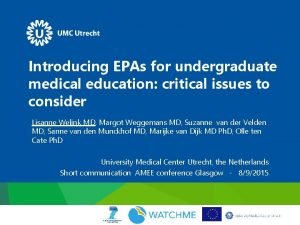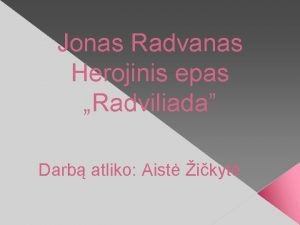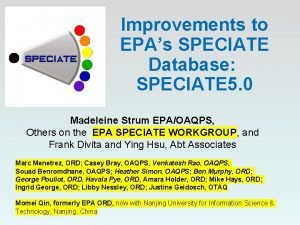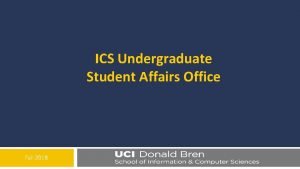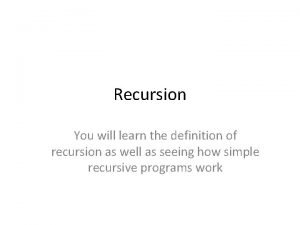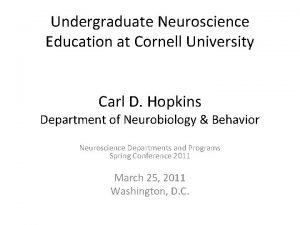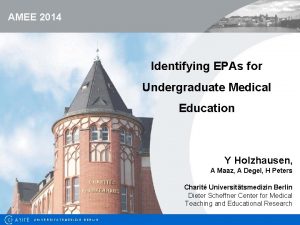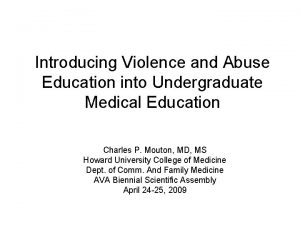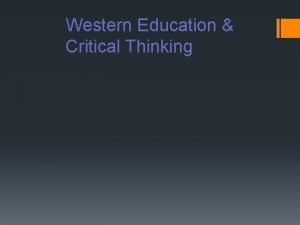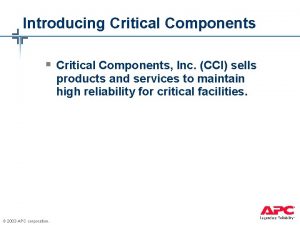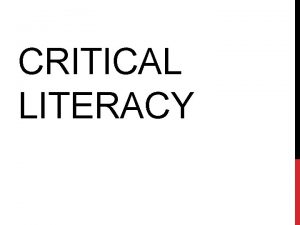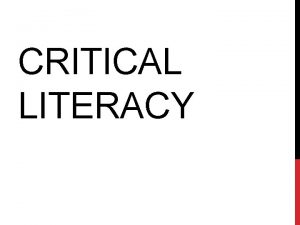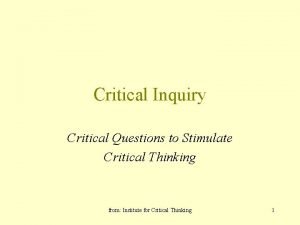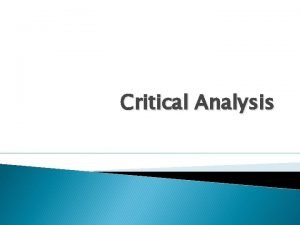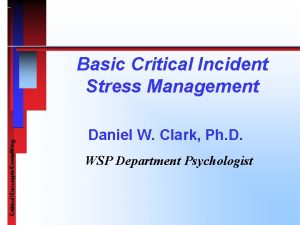Introducing EPAs for undergraduate medical education critical issues















- Slides: 15

Introducing EPAs for undergraduate medical education: critical issues to consider Lisanne Welink MD, Margot Weggemans MD, Suzanne van der Velden MD, Sanne van den Munckhof MD, Marijke van Dijk MD Ph. D, Olle ten Cate Ph. D University Medical Center Utrecht, the Netherlands Short communication AMEE conference Glasgow ‐ 8/9/2015

Content Critical issues to consider when developing EPAs for UME: 1. 2. 3. 4. Supervision levels Ad‐hoc entrustment vs. summative entrustment Discipline‐specific contributions to general EPAs Nesting EPAs Framework of EPAs for UME at UMC Utrecht

1. Stepwise decrease of supervision Issue Common entrustment and supervision scale not sufficient: – Too little gradation in first levels of supervision – Levels 4‐ 5 will not be reached during UME Common PGME entrustment and supervision scale 1 Not allowed to practice EPA 2 Allowed to practice EPA only under proactive, full supervision 3 Allowed to practice EPA only under reactive/on-demand supervision 4 Allowed to practice EPA unsupervised 5 Allowed to supervise others in practice of EPA

1. Stepwise decrease of supervision PGME entrustment and supervision scale UME entrustment and supervision scale 1. Not allowed to practice EPA 1 a: Not allowed to observe EPA 1 a: Allowed to observe EPA 2 a: As coactivity with supervisor 2. Allowed to practice EPA only under proactive, full supervision (direct) 3. Allowed to practice EPA only under reactive/on demand supervision (indirect) 2 b: With supervisor in room ready to step in as needed 3 a: With supervisor immediately available, all findings double checked 4. Allowed to practice EPA unsupervised 5. Allowed to supervise others in practice of EPA 3 b: With supervisor immediately available, key findings double checked 3 c: With supervisor distantly available (e. g. by phone), findings reviewed 4. Allowed to practice EPA unsupervised 5. Allowed to supervise others in practice of EPA Chen et al 2015

2. Ad-hoc versus summative entrustment Issue No early full (‘summative’) entrustment possible yet, but 1. Students need to practice with limited supervision 2. Student cannot always be directly supervised How to justify that students already perform tasks with limited supervision without formal entrustment?

2. Ad-hoc versus summative entrustment Solution Ad hoc entrustment: occasional permission to practice with limited supervision for educational purposes (to be confirmed every time) Summative entrustment: formalised, default permission to act with limited supervision

3. Discipline-specific contributions to general EPAs Issue • ‘Perform a physical examination’ • ‘Prioritize a differential diagnosis’ • ‘Recommend common diagnostic tests’ General skills of a physician, but these skills also require discipline‐specific skills and knowledge!

3. Discipline-specific contributions to general EPAs EG: EPA 1: ‘The clinical encounter’ Specifications 1. 2. 3. 4. 5. 6. Taking a medical history Performing physical examination Prioritize a differential diagnosis Requesting common diagnostic tests Interpret diagnostic tests Designing a treatment plan Skills and - General / internistic knowledge - Children - Gynaecological - Neurological - Psychiatrical - Dermatological - Etcetera…!

4. Nesting EPAs Issue ‐ When parts of an EPA can be practiced early, but not the full EPA ‐ Some parts are too specialized for early learners ‐ Too many observations needed within one clerkship to make a grounded entrustment decision Solution Nesting simple EPAs within complex EPAs

4. Nesting EPAs Nesting EPA (yr 3), within EPA (yr 5): • • • Capillary blood taking Venous blood withdrawal and taking a blood culture Swabs: oral, nasal, ears, skin, anal or wounds Giving infusions Ankle brachial index Administering a simple bandage and scarf bandage Urethral catheterization Suturing and injection of local anesthetic to skin Perform an ECG Give intracutaneous, subcuta‐ neous and intramuscular injections Arterial blood gas EPA 2: general medical procedures 5 th year students EPA 2 a: basic medical procedures 3 rd year students

4. Nesting EPAs Nesting EPA (yr 3), within EPA (yr 5): • • • Capillary blood taking Venous blood withdrawal and taking a blood culture Swabs: oral, nasal, ears, skin, anal or wounds Giving infusions Ankle brachial index Administering a simple bandage and scarf bandage Urethral catheterization Suturing and injection of local anesthetic to skin Perform an ECG Give intracutaneous, subcuta‐ neous and intramuscular injections Arterial blood gas EPA 2: general medical procedures 5 th year students EPA 2 a: basic medical procedures 3 rd year students

Final framework EPAs UME Utrecht EPA 1 ‘The clinical encounter’ EPA 2 ‘General medical procedures’ EPA 3 ‘Inform and advise patients and their family’ EPA 4 ‘Collaboration and communication with colleagues‘ EPA 5 ‘Patient care in special situations’ Specifications given before • About diagnostic options (incl informed consent) • About prognosis (incl breaking bad news) • About therapeutic options (incl compliance and obtaining informed consent) • Discharge letter • Oral handover • Consulting other care providers • Refer to other care providers • Perform oral presentation • Report on medical errors • Establishing patient death • Basic and advanced life support

Comparison with AAMC Core EPAs for Entering Residency (USA) UMCU: CEPAER EPA 1: Gather a history and perform a physical examination X EPA 2: Prioritize a differential diagnosis X EPA 3: Recommend and interpret common diagnostic and screening tests X EPA 4: Enter and discuss orders and prescriptions X EPA 5: Document a clinical encounter in the patient record X EPA 2 EPA 4 X X EPA 8: Give or receive a patiënt handover X EPA 9: Collaborate as a member of an interprofessional team X EPA 10: Give urgent or emergent care X EPA 11: Obtain informed consent EPA 12: Perform general procedures of a physician EPA 13: Identify system failures and contribute to a culture of safety and improvement EPA 5 X EPA 6: Give an oral presentation of a clinical encounter EPA 7: Form clinical questions and retrieve evidence EPA 3 X X X

Take-home message Implementation of an EPA‐based curriculum requires extensive discussion between curriculum designers and clinical teachers.

Thank you for your attention! Any questions? l. s. welink@umcutrecht. nl References: H. Carrie Chen, MD, MSEd, W. E. Sjoukje van den Broek, MD, and Olle ten Cate, Ph. D. The Case for Use of Entrustable Professional Activities in Undergraduate Medical Education. Acad Med. XXXX; XX: 00– 00. First published online doi: 10. 1097/ACM. 0000000586
 Critical semi critical and non critical instruments
Critical semi critical and non critical instruments Semicritical
Semicritical Epas
Epas Enabler social work
Enabler social work Epas technologies
Epas technologies Jonas radvanas
Jonas radvanas Epas database
Epas database Cosmos meaninh
Cosmos meaninh Portland state university tuition
Portland state university tuition Ics academic advisor
Ics academic advisor Undergraduate graduate postgraduate
Undergraduate graduate postgraduate Definition of undergraduate student
Definition of undergraduate student Victoria olsen
Victoria olsen Difference between postgraduate and undergraduate
Difference between postgraduate and undergraduate Difference between postgraduate and undergraduate
Difference between postgraduate and undergraduate Cornell neuroscience major
Cornell neuroscience major


